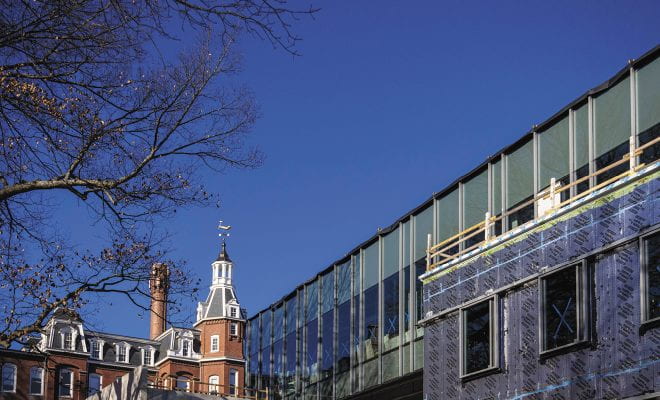Sense of Place
Spanning Four Revolutions Ascending Boynton Hill, a new academic and research building bridges WPI’s past and...
Read StoryLL: Great to talk with you and to see you. I want to talk about the School of Arts and Sciences. We know there are many science majors at WPI, but the arts, humanities, social sciences—they’re so important to every WPI graduate. How are things are going in the school?
JK: We’re doing exceptionally well. And the pieces of the school that are so important to WPI and, in general, to who we are as human beings are the fundamental and foundational skills that the arts, humanities, and social sciences and policy studies bring to us—the basic tenets of being human: critical thinking, creativity, communication, curiosity.
We try not just to foster and engage our faculty and students in these tenets, but to overlay them with STEM. And in that overlay, I think we produce students who care about their communities in an ethical manner, using all of these skill sets to have global impact.
LL: So many of your departments and programs are going to be represented in the interdisciplinary smart world approach we’re building together in our new academic building.
JK: In particular, computer science, which is in the School of Arts and Sciences, has many interdisciplinary programs, including neuroscience, data science, bioinformatics and computational biology, and interactive media and game development. And they really do that well. The idea that we collaborate across all these spaces and that computation is part of the center of this new building means that we are critical to the building, and we are excited about that.
LL: You mentioned neuroscience. That’s your background as a scientist, and it sits at the intersection of so many great things that we do here at WPI. We’ve got a new neuroscience program enrolling its first students. Talk a little bit about that.
JK: When I came to WPI, we took the pulse of the faculty to see whether this was a program they were interested in. We had 40 faculty respond from eight different departments. Some of them actually had elements of neuroscience in their courses. We got all of them together and said, “If we do neuroscience at WPI, how is it going to be different? How is it not going to look like every other neuroscience program?”
We thought about the strengths of WPI, the strengths of computational biology, the strengths of computer science, the strengths of data science, the strengths of all these digital modules. Our neuroscience program here looks quite different in that it features computation at its core. It’s a computational neuroscience program.
LL: That’s so exciting. You are an academic leader here at WPI, but you also focus on health and wellness for our broader community. You catalyzed a group of folks across the institution to create an initiative during this time of COVID, when we can all feel so isolated and apart, called Be Well Together. Tell us about that.
JK: My background in neuroscience also speaks to this initiative, because as a neuroscientist, what I study is the impact of stress on the brain and the interaction between stress and the brain. For stress researchers, COVID represented the culmination of things we never want to see together: something that’s chronic, something that’s unpredictable, and something that’s uncontrollable. Those are the three areas we look at to understand stress better. And we had, on top of it, isolation, which we had never modeled.
We’d been talking about wellness since I got here and some people had already been engaged in wellness practices. When COVID hit, we quickly got a few of them together and said, what can we do immediately to respond? We pulled together our head of Humanities and Arts, Kate Moncrief, professors Jeanine Skorinko and Angela Rodriguez, and staff members in the library who were already offering mindfulness. We asked them, “Could you do this for our community?” And they said yes.
It has been amazing. I have to thank the School of Engineering for co-sponsoring these events. We’re really excited about the fact that although we’re isolated, we’re really together in terms of wellness.
LL: Thank you for the part you’ve played in bringing our community together. And thank you so much for being with us.
Watch the full interview below

Spanning Four Revolutions Ascending Boynton Hill, a new academic and research building bridges WPI’s past and...
Read Story